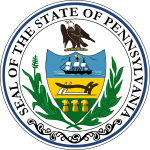1806 United States House of Representatives elections in Pennsylvania
| |||||||||||||||||||
All Pennsylvania seats to the United States House of Representatives | |||||||||||||||||||
|---|---|---|---|---|---|---|---|---|---|---|---|---|---|---|---|---|---|---|---|
| |||||||||||||||||||
| Elections in Pennsylvania |
|---|
 |
|
|
Elections to the United States House of Representatives were held in Pennsylvania on October 14, 1806, for the 10th Congress.
Background
In the previous elections, 17 Democratic-Republicans and 1 Federalist had been elected to represent Pennsylvania. There were two subsequent special elections which did not result in any seats changing parties. One seat held by a Democratic-Republican had become vacant and was not yet filled at the time of the election.
As in the previous election, there was a breakaway faction of the Democratic-Republican Party allied with the Federalists known as the tertium quids or Constitutional Republicans, which ran candidates in several districts. Several of the elected quids aligned with the Federalists on the federal level.
Congressional districts
Pennsylvania was divided into 11 districts, of which four were plural districts with 11 Representatives between them, with the remaining 7 Representatives elected from single-member districts. The districts were:
- The 1st district (3 seats) consisted of Delaware and Philadelphia counties (including the City of Philadelphia)
- The 2nd district (3 seats) consisted of Bucks, Luzerne, Montgomery, Northampton, and Wayne Counties
- The 3rd district (3 seats) consisted of Berks, Chester, and Lancaster Counties
- The 4th district (2 seats) consisted of Cumberland, Dauphin, Huntingdon, and Mifflin Counties
- The 5th district consisted of Centre, Clearfield, Lycoming, McKean, Northumberland, Potter, and Tioga Counties
- The 6th district consisted of Adams and York Counties
- The 7th district consisted of Bedford and Franklin Counties
- The 8th district consisted of Armstrong, Cambria, Indiana, Jefferson, Somerset, and Westmoreland Counties
- The 9th district consisted of Fayette and Greene Counties
- The 10th district consisted of Washington County
- The 11th district consisted of Allegheny, Beaver, Butler, Crawford, Erie, Mercer, Venango, and Warren Counties
Note: Many of these counties covered much larger areas than they do today, having since been divided into smaller counties
Election results
Fifteen incumbents (14 Democratic-Republicans and the sole Federalist) ran for re-election, of whom eleven won re-election. The incumbents Isaac Anderson (DR) and Christian Lower (DR), both of the 2nd district did not run for re-election and one seat in the 1st district was vacant, the previous incumbent Michael Leib (DR) having resigned February 14, 1806. Two seats changed from Democratic-Republican to Federalist control.
Election results are unavailable for the 8th district.
| District | Democratic-Republican | Quid | Federalist | Unknown | ||||||||
|---|---|---|---|---|---|---|---|---|---|---|---|---|
| 1st 3 seats |
John Porter[1] | 4,857 | 21.1% | John Sergeant | 1,578 | 6.8% | William Graham | 4,223 | 18.3% | |||
| Jacob Richards (I) | 4,770 | 20.7% | Joseph Hemphill | 2,922 | 12.7% | |||||||
| Joseph Clay (I) | 4,700 | 20.4% | ||||||||||
| 2nd 3 seats |
Robert Brown | 5,180 | 18.0% | William Milnor[2] | 4,824 | 16.8% | ||||||
| John Pugh | 4,761 | 16.6% | Frederick Conrad (I) | 4,659 | 16.2% | |||||||
| John Hahn | 4,750 | 16.5% | William Latimore | 4,589 | 16.0% | |||||||
| 3rd 3 seats |
John Whitehill (I) | 5,666 | 15.5% | John Hiester | 6,709 | 18.3% | ||||||
| Roger Davis | 5,545 | 15.2% | Matthias Richards | 6,625 | 18.1% | |||||||
| William Witman | 5,539 | 15.1% | Robert Jenkins[2] | 6,487 | 17.7% | |||||||
| 4th 2 seats |
Robert Whitehill (I) | 6,024 | 47.7% | Oliver Pollock | 225 | 1.8% | ||||||
| David Bard (I) | 5,388 | 42.7% | ||||||||||
| Evers Doty | 983 | 7.8% | ||||||||||
| 5th | Daniel Montgomery, Jr. | 3,161 | 57.7% | Andrew Gregg (I) | 2,321 | 42.3% | ||||||
| 6th | James Kelly[2] (I) | 2,979 | 100% | |||||||||
| 7th | John Rea (I) | 1,511 | 52.7% | Henry Woods | 503 | 17.6% | Andrew Dunlap | 852 | 29.7% | |||
| 8th | William Findley (I) | 100% | ||||||||||
| 9th | John Smilie (I) | 1,987 | 100% | |||||||||
| 10th | William Hoge | 1,203 | 62.0% | John Hamilton (I) | 737 | 38.0% | ||||||
| 11th | Samuel Smith | 3,339 | 55.9% | John Wilkins[2] | 2,621 | 44.1% | ||||||
Special election
Joseph Clay (DR) of the 1st district resigned March 18, 1808. A special election was held October 11, 1808, the same day as the 1808 general elections.
| District | Democratic-Republican | Federalist | ||||
|---|---|---|---|---|---|---|
| 1st | Benjamin Say | 7,598 | 55.7% | Charles W. Hare | 6,046 | 44.3% |
References
- Electoral data and information on districts are from the Wilkes University Elections Statistics Project
